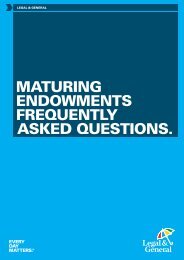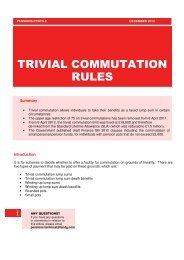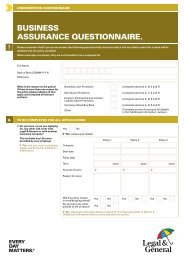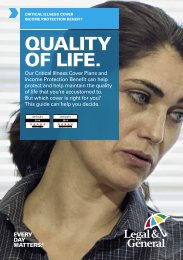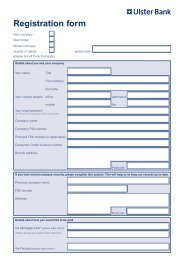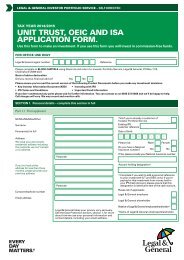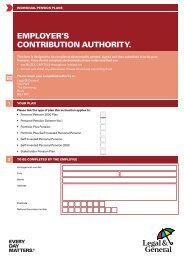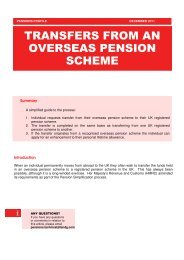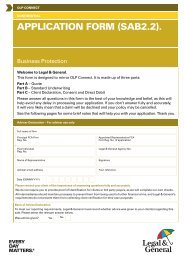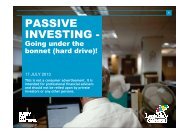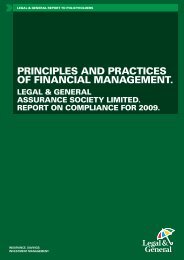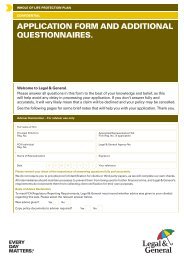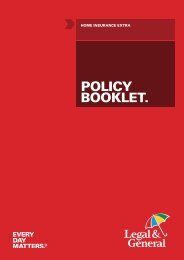Guide to Key Person Protection (W13226) - Legal & General
Guide to Key Person Protection (W13226) - Legal & General
Guide to Key Person Protection (W13226) - Legal & General
You also want an ePaper? Increase the reach of your titles
YUMPU automatically turns print PDFs into web optimized ePapers that Google loves.
KEY PERSON PROTECTION – TECHNICAL GUIDEYOUR GUIDE TO KEYPERSON PROTECTION.
4 KEY PERSON PROTECTION – TECHNICAL GUIDEWHAT IS A LIMITED LIABILITYPARTNERSHIP (LLP)?The Limited Liability Partnership Act 2000established a new form of business vehicle.An LLP gives the benefits of a limited liability asfor a company, but allows its members theflexibility of organising their internal structure asa partnership. The LLP is a legal entity separatefrom its members and while the LLP itself is liablefor the full extent of its debts, the liability of themembers will be limited (except <strong>to</strong> the extent thatthe members agree otherwise). Any two or moreindividuals can incorporate as an LLP.In short it is a half way house between a companyand a partnership.This business format is becoming increasinglypopular among professional practices, such asaccountants and solici<strong>to</strong>rs.An LLP may own an insurance policy directly.The LLP applies for the policy and completes thepolicy owner questionnaire. In the event of a validclaim the policy proceeds would be payable <strong>to</strong> thebusiness. As the LLP is the owner of the policy itwould usually pay the premiums.WHAT TYPE OF POLICY SHOULDBE EFFECTED?This depends on the circumstances involved andthe events the business wish <strong>to</strong> insure the keyperson against.You can choose either life cover or life and criticalillness cover.The effect of suffering from a critical illness canbe the same on the business as the death of the keyperson. Therefore, life and critical illness cover maybe a suitable option.We recommend that the business think about thelength of the period of cover first of all. Then the riskor risks they wish <strong>to</strong> be insured against, the amoun<strong>to</strong>f cover, affordability and finally taxation.The key person will have <strong>to</strong> complete their personaland medical details and also sign the application asthe life assured.SO HOW DO YOU CALCULATE THE AMOUNTOF COVER?When calculating the appropriate amount of coverneeded you should consider the effect of the loss ofthe key person on the business including whetherthis would directly impact on the profits, and whatthe cost of hiring a replacement might be.There are common formulas which can be used <strong>to</strong>help identify an appropriate amount:1. A simple formula is <strong>to</strong> take a multiple of the keyperson’s earnings. This can often be up <strong>to</strong> 10times the key person’s earnings for death, witha lower figure considered for critical illness.This takes account of the cost <strong>to</strong> the business ofreplacing a key individual and would normallyinclude consideration of the costs involvedin finding a suitable person, the expense ofrequired training, and also their earnings whilstthey develop in the role.2. Another method is <strong>to</strong> calculate the amount ofcover based on their contribution <strong>to</strong> profits,where this is the need <strong>to</strong> be covered. Commonformulas used are:– up <strong>to</strong> 2 x proportion of gross profit directlyattributable <strong>to</strong> key person;– up <strong>to</strong> 5 x proportion of net profit directlyattributable <strong>to</strong> key person;– (key person salary/<strong>to</strong>tal payroll for business) xgross profit x recovery period (max five years).In all the above formulas an average of the lasttwo years profit figures would routinely be used.3. The amount of the loan <strong>to</strong> be repaid on the deathof the key person.We can offer assistance in calculating the amoun<strong>to</strong>f cover with our key person calcula<strong>to</strong>r available onour website.WHAT HAPPENS IF THE KEY PERSON LEAVESOR RETIRES?If a key person were <strong>to</strong> leave or retire beforethe end of the key person protection policy term,the business could do one of the following:• S<strong>to</strong>p paying the premiums and the policy wouldthen lapse.• Continue paying the premiums until the endof the policy term and in event of a claim, thebusiness would receive a capital sum.• Assign the policy <strong>to</strong> the key person who thenwould become the legal owner of the policy andcould then continue paying the premiums.Where a partner is a key person and the policy iswritten in trust, the policy would au<strong>to</strong>maticallyrevert <strong>to</strong> the key person.
KEY PERSON PROTECTION – TECHNICAL GUIDE5WHAT ARE THE KEY TAXATIONEFFECTS FOR COMPANIES ANDLIMITED LIABILITY PARTNERSHIPS?CORPORATION TAXWhere the policy is on the life of an employeethe tax treatment of premiums is likely <strong>to</strong> largelydepend on what have become known as the‘Anderson principles’ – based on comments madeby the then chancellor, Sir John Anderson, in 1944– along with other related legislation and HMRCguidance.Essentially, if certain important criteria are met, thetax treatment of a key person policy should be that:– The company can treat the premiums it pays asallowable business expenses, deductible fromthe company’s profits (potentially reducing itsCorporation Tax liability every year it has thepolicy).– The company will have <strong>to</strong> account for anyproceeds from the policy as a trading receipt(potentially increasing its Corporation Tax liabilityin the year of receipt).The important criteria <strong>to</strong> be met are that:a. The policy must be ‘short term’. While this isnot a defined period, it should not be beyondthe period of the employee’s usefulness <strong>to</strong> thecompany. Premiums on whole of life plans areunlikely <strong>to</strong> meet this.b. The policy must cover an expected loss of profits.Where the policy is intended <strong>to</strong> cover repaymen<strong>to</strong>f a loan, the premiums are unlikely <strong>to</strong> beallowable expenses.c. The nature of the relationship between thecompany and the life assured must be tha<strong>to</strong>f employer/employee, while the policy andits premiums must be effected wholly andexclusively for business purposes. Where the keyperson owns an interest in the company, this canlead <strong>to</strong> complications.It should be noted that though the Andersonprinciples give good guidance as <strong>to</strong> how the localinspec<strong>to</strong>r of taxes is likely <strong>to</strong> consider the taxposition, they are not binding in law. Because ofthis, in each case, we would recommend that thebusiness seek the guidance of the local inspec<strong>to</strong>r oftaxes directly.Where the important criteria are not met, and thepremium payments are not considered as allowableexpenses, the company may or may not still have<strong>to</strong> account for the policy proceeds on receipt. Thiswill be at the discretion of the local inspec<strong>to</strong>r oftaxes, however, unlike the position with respect <strong>to</strong>premiums, it is unlikely that the inspec<strong>to</strong>r wouldgive any clear indication about the potential futuretreatment of proceeds.It’s not right <strong>to</strong> assume that electing <strong>to</strong> give upCorporation Tax relief on the premiums wouldresult in tax-free policy proceeds. The guidance ofthe company’s tax inspec<strong>to</strong>r should be sought. Aspecimen letter is attached in Appendix 1. Pleasevisit our website <strong>to</strong> download the specimen letter.<strong>Key</strong> person cover shouldn’t necessarily berestricted <strong>to</strong> policies where Corporation Tax reliefon premiums may be available. It may be wiser <strong>to</strong>try and ensure that the policy proceeds are receivedfree of tax. In any event, if the amount of coveris based on gross profits, the fact that it’s taxabledoesn’t matter.For an LLP, premiums may be allowable as abusiness expense if the key person is an employeeof the business.CAN KEY PERSON PROTECTION BE EFFECTEDON A DIRECTOR WITH A SIGNIFICANTSHAREHOLDING?If the company’s tax inspec<strong>to</strong>r feels that the policyproceeds will be for the benefit of the life assured(because he has a significant share) and it is unlikelythat tax relief would be granted on premiums. Ageneral rule is that where the shareholding is lessthan 5% tax relief should be available.ARE THERE INHERITANCE TAX ISSUES?A cash injection via policy proceeds will tend <strong>to</strong>increase the value of the business. If the deceasedkey person was also a shareholder, the value oftheir estate would be increased. If the shares werepassing <strong>to</strong> someone other than the spouse orregistered civil partner, and business relief wasn’tfully available, any Inheritance Tax liability may beincreased.CAPITAL GAINS TAXA Capital Gains Tax liability may arise, in the event ofthe sale of an individual’s share in the business due<strong>to</strong> a terminal or critical illness.There may be other taxation implications but thiswill depend on your individual circumstances. Westrongly recommend that you consult your ownlegal or tax adviser before proceeding.
6 KEY PERSON PROTECTION – TECHNICAL GUIDETAX AND TRUST INFORMATIONFOR PARTNERSHIPS.WHY USE A TRUST FOR A PARTNERSHIP?A partnership in England, Wales and Northern Irelandcannot be the owner of a policy because it does not havea seperate legal identity. If the key person is one of thepartners, that partner could take out an own life plan, andwrite it in trust at outset for the other partners.WHAT IS A TRUSTEE?A trustee is someone appointed <strong>to</strong> look after the asset(s)they are putting in trust (for example, their <strong>Legal</strong> & <strong>General</strong>business protection policy). The trustees are the legalowners of the trust assets, and must act for the benefi<strong>to</strong>f the beneficiaries of the trust. In the event of the keyperson’s death, the trustees will need <strong>to</strong> make a claimfor the proceeds and ensure that these are passed <strong>to</strong> thebeneficiaries of the trust.WHO CAN BE A TRUSTEE?The partner who is the key person is au<strong>to</strong>matically atrustee and normally the other partners could also beappointed. It is a good idea for them <strong>to</strong> be resident in theUnited Kingdom. Solici<strong>to</strong>rs and accountants can act astrustees but they will charge for their services.CAN ADDITIONAL TRUSTEES BE APPOINTED INTHE FUTURE?Yes, our trusts allow the appointment of additionaltrustees at any time.THE ADDRESS TO SEND THESE ITEMS TO IS:<strong>Legal</strong> & <strong>General</strong> Life Claims DepartmentCity ParkThe DrovewayHove, East Sussex BN3 7PYOnce the claim is accepted, the trustees will be paidby direct credit.TAXATION OF A PARTNERSHIPThere will be no tax relief on the premiums and thesum assured will not be taxed.INHERITANCE TAX ISSUES FOR POLICIESPLACED IN TRUST.Whilst a policy in the Partnership <strong>Protection</strong> Trustwill not form part of the key person’s estate forInheritance Tax, there are some occasions wherethere is a potential for an Inheritance Tax charge <strong>to</strong>arise. For example, on each 10 year anniversary ofthe trust (periodic charge) and when payments aremade out of the trust (exit charge).If a term assurance policy with no surrender value isplaced in trust, then provided that the life assured isin good health the value of the policy for InheritanceTax is likely <strong>to</strong> be negligible. The maximum charge is6% of the value of the trust fund in excess of the nilrate band.HOW DO THE TRUSTEES MAKE A CLAIM?In the event of the key person’s death the trusteeswill need <strong>to</strong> send the following items <strong>to</strong><strong>Legal</strong> & <strong>General</strong>’s Life Claims Department:• Partnership Trust (and any subsequent deeds);• The original policy schedule;• A death certificate.
KEY PERSON PROTECTION – TECHNICAL GUIDE7APPENDIX 1: SPECIMENHM REVENUE & CUSTOMS LETTER.Below is a draft letter which could be used as a guide for companies wishing <strong>to</strong> find out the tax position on a keyperson policy from the HM Revenue & Cus<strong>to</strong>ms.To: HM Inspec<strong>to</strong>r of TaxesDear SirsXYZ COMPANY LIMITEDThe above company wishes <strong>to</strong> effect a key person policy on the life of NAME OF LIFE ASSURED for its own benefit.The type of policy chosen is a <strong>Legal</strong> & <strong>General</strong> NAME OF CONTRACT and will not acquire a surrender value.Details of the contract are as follows:Type of contract:Amount of cover £payable on death/death or earlier terminal illness/death or earlier terminal illnessand/or earlier critical illness/<strong>to</strong>tal permanent disability.*Other benefits:Term of policy:LEVEL Annual/monthly premium: £NAME OF LIFE ASSURED presently holds the position of TITLE within the company.NAME OF LIFE ASSURED:†• Owns none of the shares in the company.• Owns XXX% shares in the company.• Is a substantial shareholder in the company.• The policy is <strong>to</strong> compensate the above company for the anticipated loss of profits if the serviceof NAME OF LIFE ASSURED were no longer available.OR• The policy is security for a loan/loans*, which will become repayable on the death ofNAME OF LIFE ASSURED within the loan period of X years.I would be grateful if you could confirm in writing whether the premiums paid under the above policy willbe treated as a business expense for Corporation Tax purposes and whether the policy proceeds will betreated as a trading receipt or a non-taxable item on the capital account.Yours faithfullyFor XYZ COMPANY LIMITED* Delete as appropriate† Select as appropriateThe above is purely a draft and it is essential that professional advice is sought before any action is taken.
<strong>Legal</strong> & <strong>General</strong> Assurance Society LimitedRegistered in England No. 166055Registered office: One Coleman Street, London EC2R 5AAAuthorised by the Prudential Regulation Authority and regulated by the Financial Conduct Authority and the Prudential Regulation Authority.We are members of the Association of British Insurers.<strong>W13226</strong> 05/13 NON GASDwww.legalandgeneral.com



